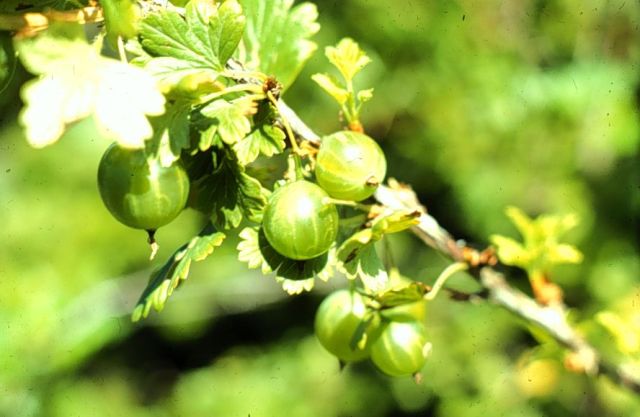Gooseberry Production in Manitoba
Description

Gooseberries (Ribes spp.) and currants are closely related and belong to the Saxifrage family. The American gooseberry is listed as Ribes hirtellum (Michx.) and the European gooseberry as Ribes grossularia L. There are a large number of gooseberry cultivars available with a wide range in fruit colour, including red, yellow, green, and white. Gooseberries are small deciduous shrubs native to Canada. Gooseberries range in height from two to five feet (0.6 to 1.5 m). Gooseberries appear very similar to currants except they have spines along the stem.
Gooseberries produce flowers on one-year-old shoots with the inflorescences containing one to three flower buds. Gooseberries are self-fertile and do not require pollination, however, greater yields can be produced if the flowers are cross- pollinated. One hive per acre is recommended to ensure good pollination.
Gooseberries are very hardy and can withstand temperature of -22 to 31°F (-30 to -35°C). The flowers are tolerant to frost and can withstand temperatures between 31 and 28°F (-0.5 to 2.0°C) when open, 27 to 23°F (-3 to -5°C) when closed. Small fruit can withstand temperatures between 28 and 27°F (-2 to -3°C).
UsesGooseberries are used for industrial processing for jam and syrup. They are also eaten fresh, can be stewed, or used as fillings. Gooseberry fruit will keep one to two days at room temperature and up to seven days if refrigerated.
Site Selection/ Spacing/Rooting Depth
Gooseberries require a well-drained, deep loamed soil with soil organic levels greater than one percent. The planting site should occur on a northern, northeast, or northwest facing slope. Gooseberries grow best in soil with a pH of between 5.5 and 7.0. The spacing between plants should be three to four feet (1.0 to 1.25 m) and between row spacing can be as close as 6.5 ft (2 m) but a spacing of eight to nine feet (2.4 to 2.7 m) is preferred. Gooseberries are shallow-rooted with the roots primarily located in the top eight to 16 in. (20 to 40 cm) of the soil. The spread of the root system does not usually extend beyond the canopy of the plant.
Harvesting/Nutritional Value
Gooseberries require some time after planting to begin bearing fruit but will be productive for between 15 and 20 years. Gooseberries can be harvested before they are ripe because they contain high levels of pectin, but they are more tart. Fruit that is ripe can remain on the plant for up to seven days without much of a problem. This characteristic makes it easy to harvest the crop with mechanical harvesters. Hand-held harvesters can also be used. A yield of six quarts (7 L) per mature bush in considered good.
One pound (450 g) of raw gooseberries con-tains, 178 calories, 3.6 g of protein, 0.9 g of fat, 44 g of carbohydrates, 100 mg of calcium, 2.3 g of iron, 1,330 IU of vitamin A, 0 mg of thiamine, 0 mg of riboflavin, 0 mg of niacin, and 149 mg of vitamin C.
Note: Gooseberries are an alternate host for white pine blister rust. Gooseberries should not be planted within 1000 ft (300 m) of white pine trees.

